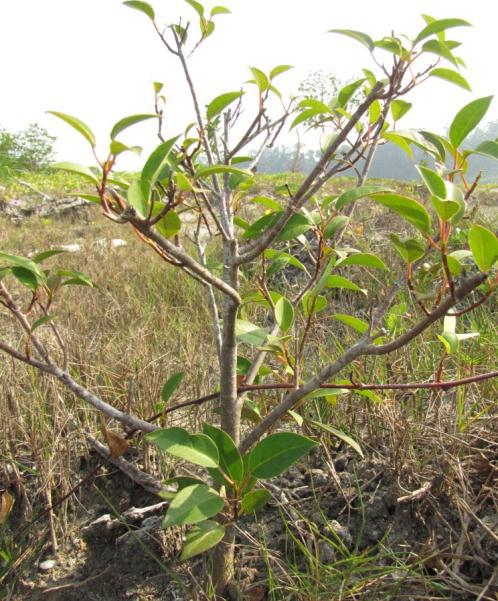Bhanu Sridharan
The main objective of this project is to identify the factors that aid and constrain natural regeneration of different species of plants in mangrove forests damaged by natural events like the tsunami. By identifying these factors we hope to develop better restoration techniques in mangrove patches that are not regenerating naturally.

Exoceria saplings which have disappeared from areas where land has subsided.
Mangrove forest area in the Andaman Islands has declined from 1000 km2 in 1977 to 671km2 in 2003 (FSI 2003). The 2004 tsunami precipitated this decline, leading to loss of mangrove cover in the islands. After this event mangroves have been viewed primarily as bio-shields. Huge amounts of resources have thus been spent to restore coastal vegetation, but in an unscientific and arbitrary manner. Restoration activities mainly include planting exotic trees such as Casuarina spp. or monospecific mangrove stands comprising a few fast growing species such as Rhizophora spp. Such practices can lead to further loss of biodiversity and valuable ecosystem services that these habitats provide.
Since mangroves forests that undergo rare stresses, like tsunamis, are able to naturally regenerate, restoration may also be unnecessary. Understanding what factors aid and constrain regeneration of different mangrove species can shed light on the extent of human intervention that is required.
This project aims to identify the key factors that facilitate (e.g. availability of space) and constrain (e.g. propagule predation) natural regeneration of different species of mangrove trees. For this study the definition of natural regeneration is restricted to germination of propagules. These seedlings will then be continuously monitored for a minimum of 12 months to account for seasonal variation in growth rate and mortality in different species.
In addition to this, we plan to conduct nursery experiments where propagules will be exposed to varying regimens of light/shade, soil types, salinity levels and predation levels. This allows us to further confirm which factors allow successful germination and will be easy to manipulate for successful plant growth. This can be useful information in cases where active restoration may need to be applied.
Furthermore the project aims to identify potential areas where natural regeneration may not be happening and restoration activities might be required. This will allow managers to focus resources and time on areas that actually require interventions. We also hope to develop field protocols for long term monitoring of these damaged forests and also organise workshops where the forest department may be trained to monitor damaged and newly restored mangrove forests to gauge the efficacy of such interventions in preserving biodiversity.